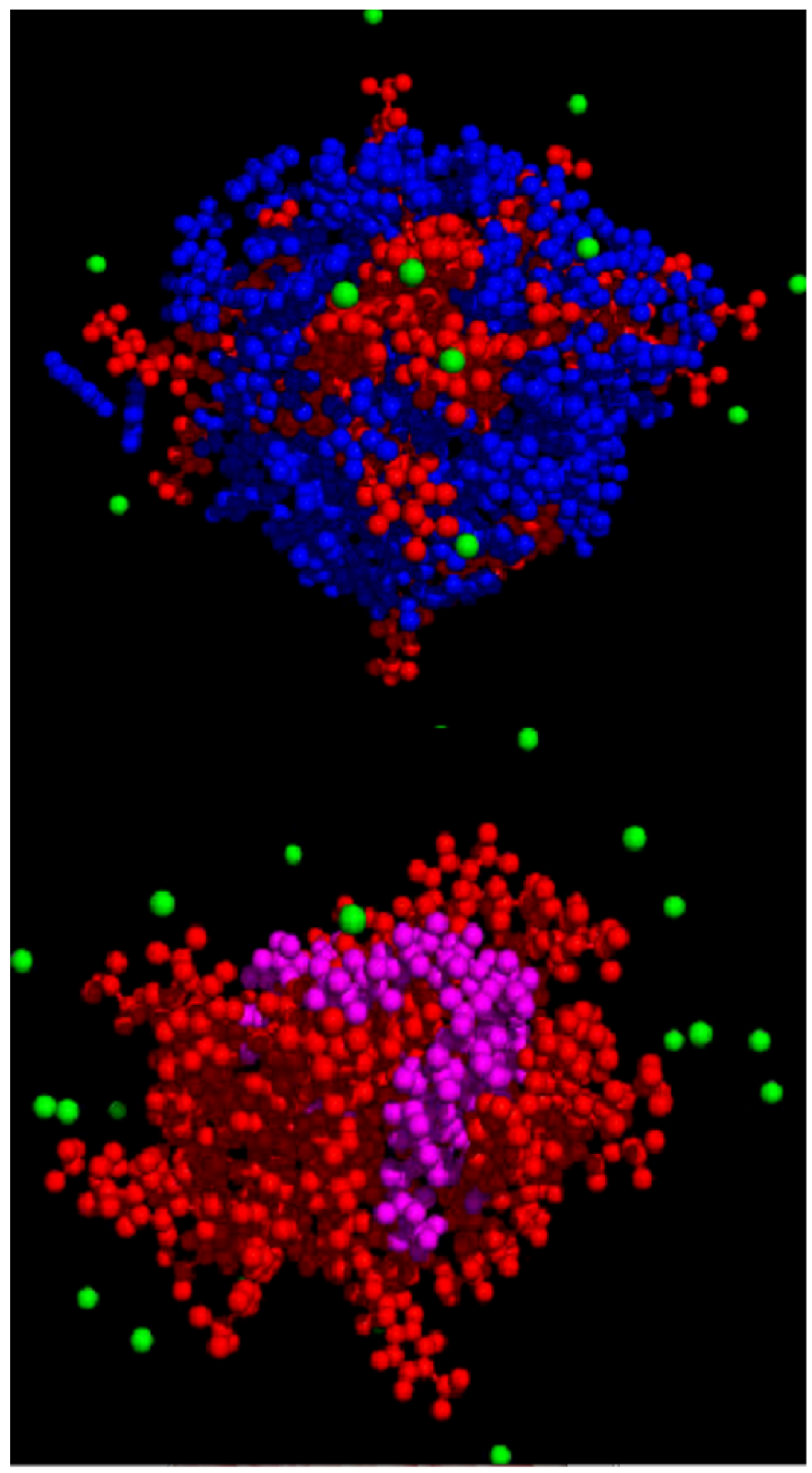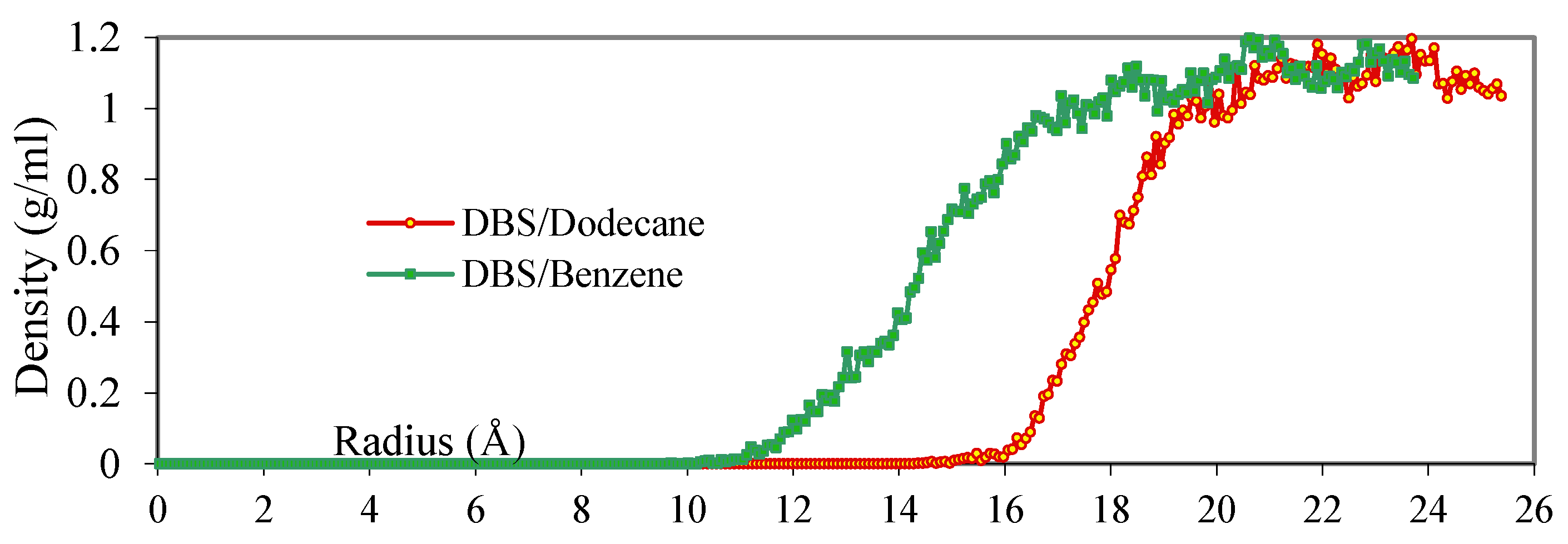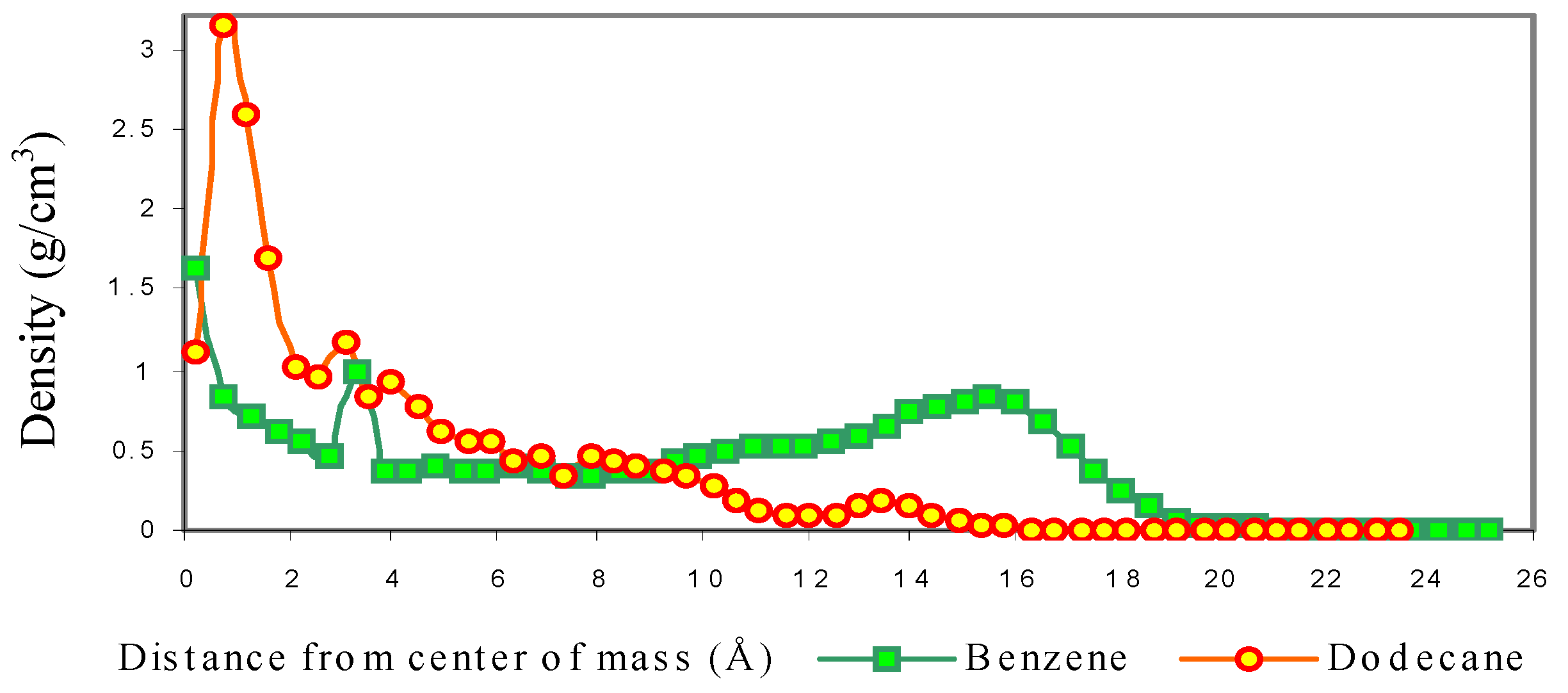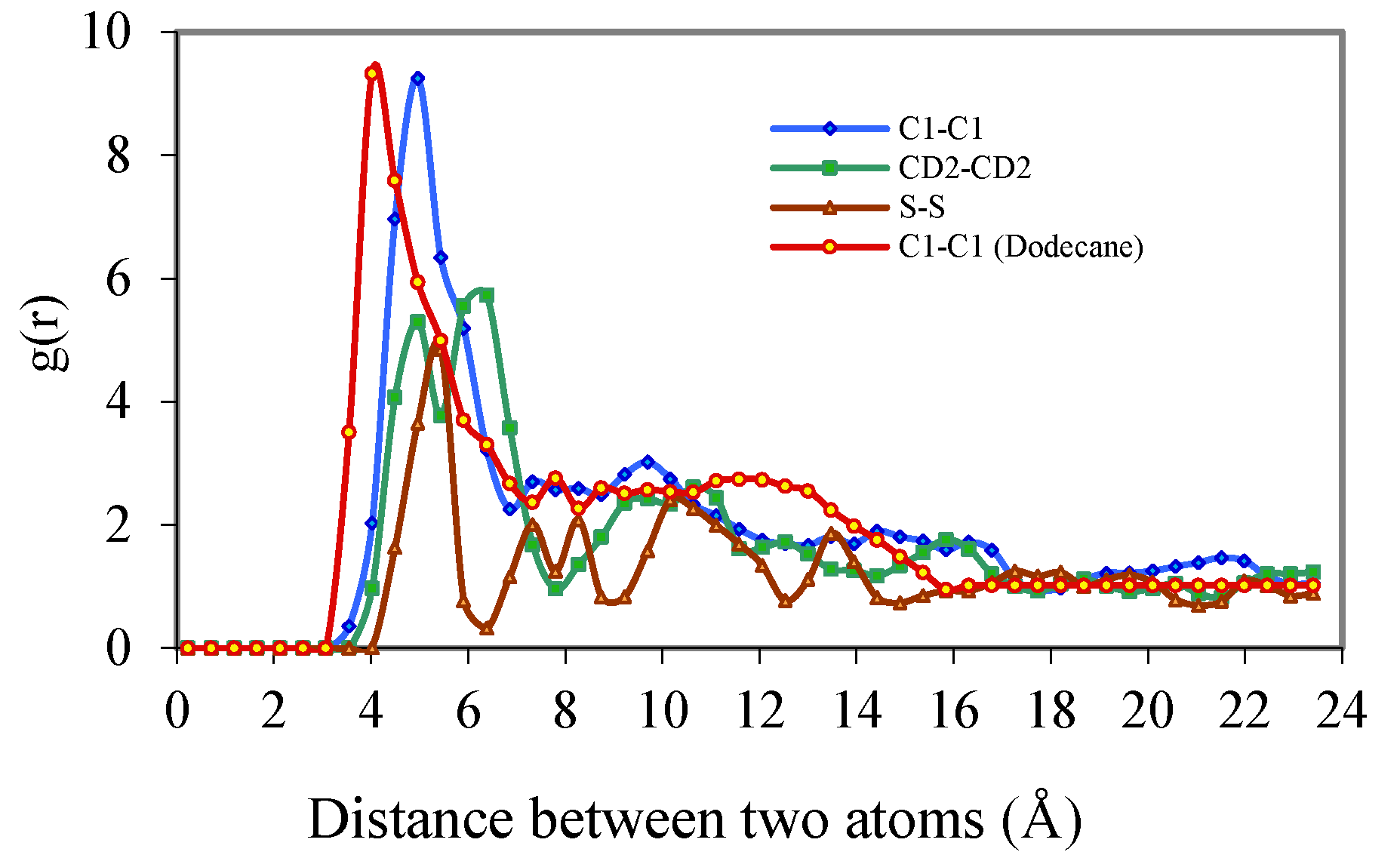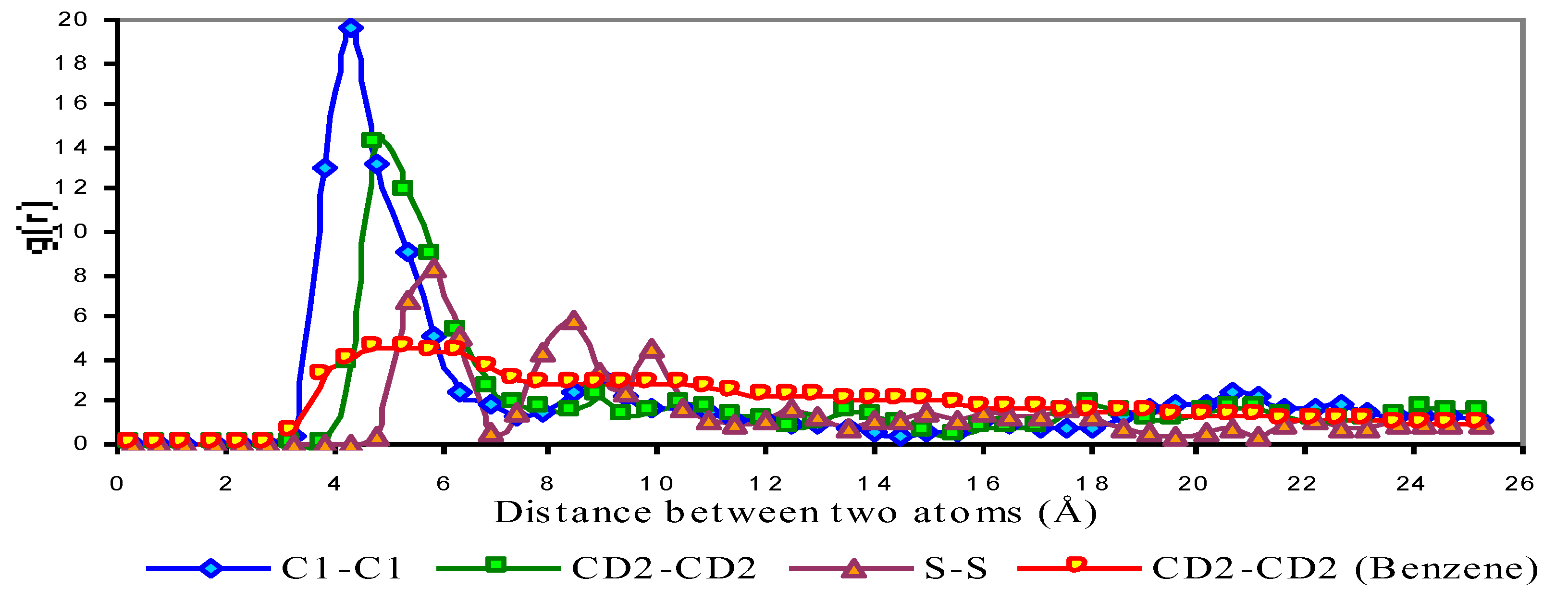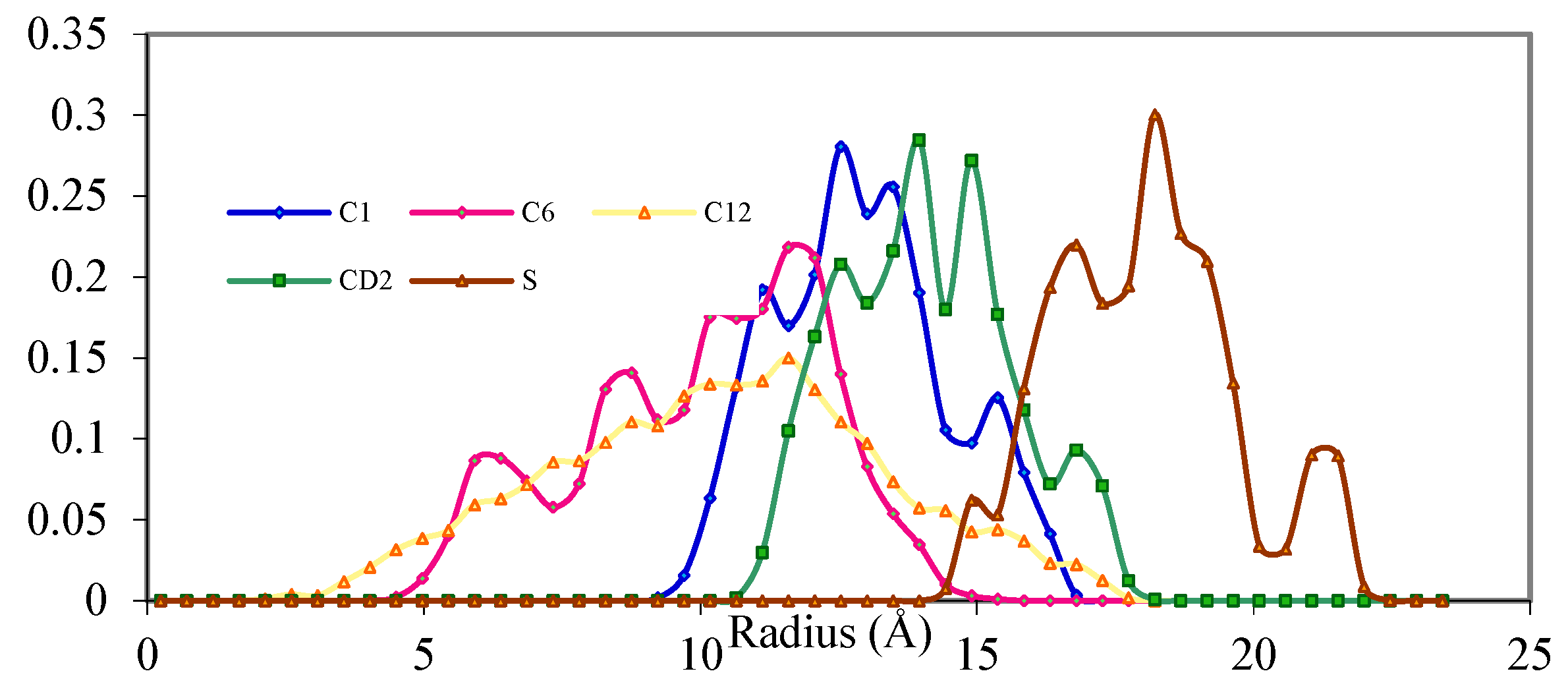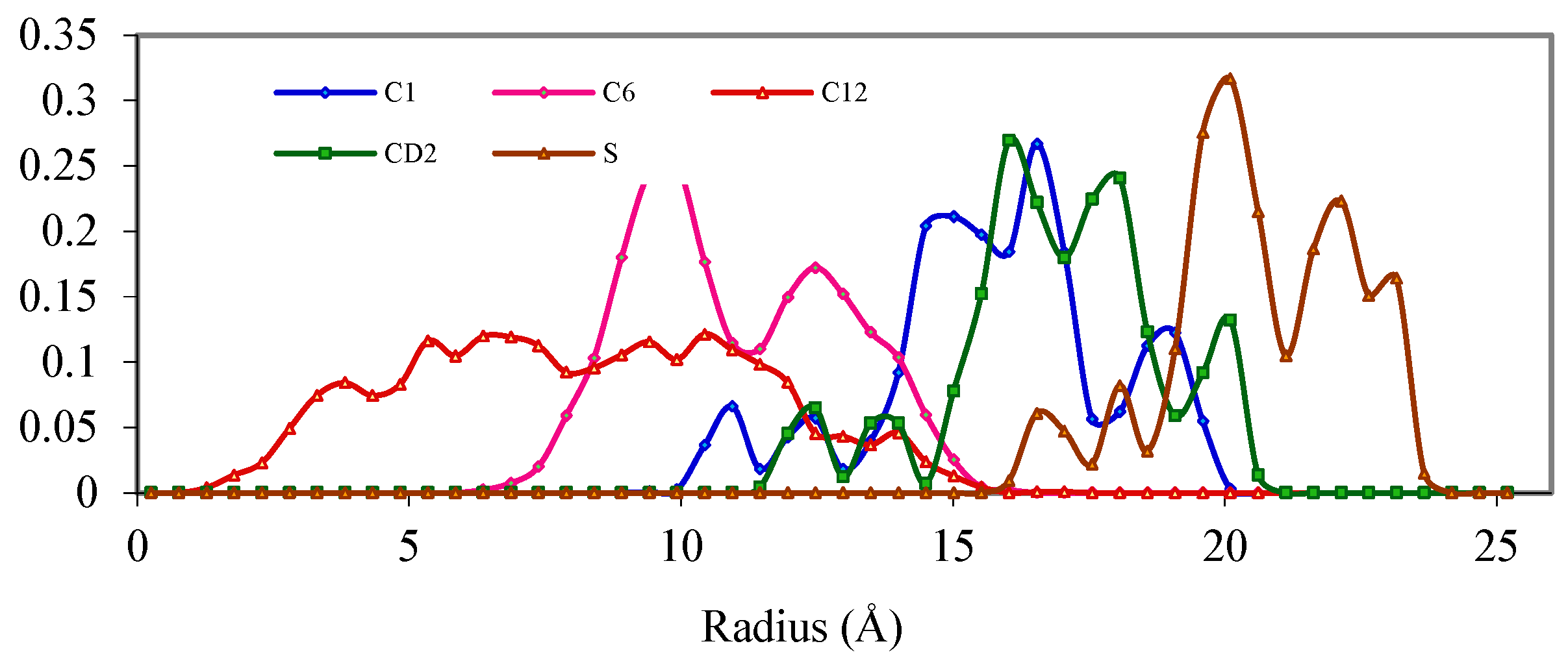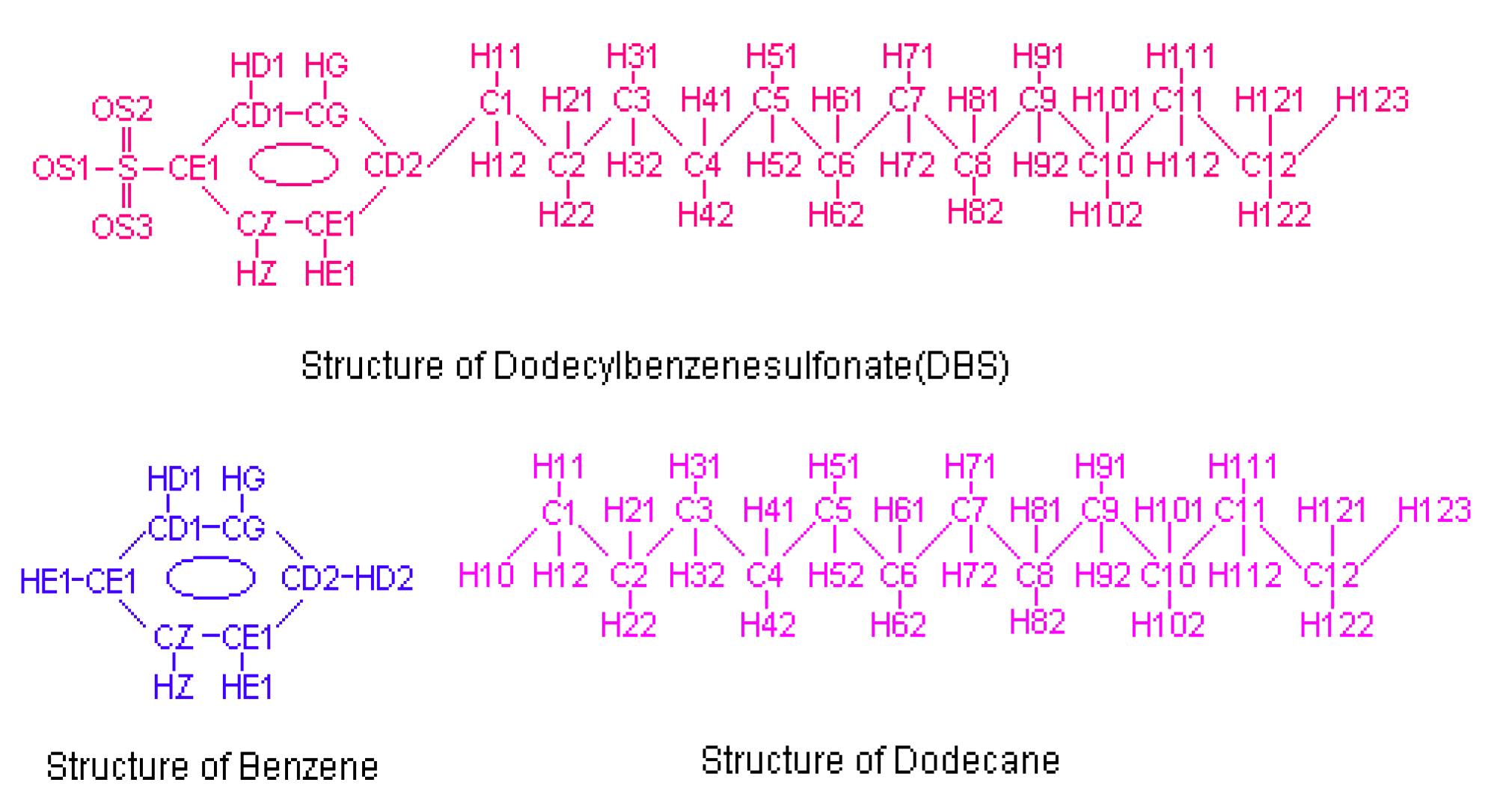Simulation output file coordinates of equilibrated structures are depicted as a space-filling model in
Figure 1. Equilibrated structure results are consistent with previous reports that aromatic hydrocarbons tend to influence micelle structure by decreasing interfacial tension yielding a larger area per head group [
1]. It is hypothesized that the aromatic compounds insert between the surfactant molecules on the interface and alter the interfacial properties between the two phases [
1].
3.1. Localization of Water and Solutes within Micelle
Simulation results also indicate that water molecules penetrate approximately 4 Å deeper into the DBS/Benzene micelles than into the DBS/Dodecane micelles (
Figure 2). The more hydrophilic benzene molecules at the outer layer of the micelle can “open” the micelle up for water molecules to penetrate the inner region. It is also noticed that the water/micelle interface is sharper for the DBS/Dodecane micelle (
Figure 2). Since the interior of the DBS/Dodecane micelle is packed tightly with surfactant tail groups and dodecane molecules, which are highly hydrophobic, once the water molecules penetrate past the hydrophilic group of DBS they will meet strong resistance and are stopped quickly. In contrast, in the DBS/Benzene micelle structure, the benzene molecules are evenly distributed in the micelle, and the hydrophilic and hydrophobic regions of the micelle are not clearly distinguished.
For the DBS/Dodecane micelle, the hydrophobic dodecane molecules remain near the centre of mass (
Figure 3). It is also observed that the movement of dodecane molecules is strongly limited at the end of the simulation. The core of DBS/Benzene micelle is mainly occupied by benzene molecules due to its smaller molar volume. It can be observed that the density of benzene remains almost constant from 2–12 Å which means the benzene can move around within this hydrophobic core area of micelle (
Figure 3). The density of benzene increases slowly from 12 Å to 15 Å, and this peak area represents where the majority of benzene molecules reside in the system in the outer layers of the micelles. From 17 Å the density of benzene drops lower than the average density within the density in the micelle, slowly decreasing to zero at around 20 Å. It is very interesting that the boundary of DBS/Benzene micelle is actually defined by a benzene/water interface, as there is no sharp boundary between micelle and solvent, while the DBS/Dodecane micelle is defined by the hydrophobic core area occupied by dodecane and DBS monomer tail groups, possesses a boundary that is very sharp, similar to that reported for micelles that are formed by pure surfactant molecules in the absence of solute [
9].
3.2. Radial Distribution Function
The radial distribution function (RDF) is calculated from the pair distribution function
g2 (
ri, r
i), or simply
g(
r), and represents the probability of finding a pair of atoms a distance r apart, relative to the probability expected for a completely random distribution of atoms at the same density [
10]. This was calculated using standard approaches [
11].
Figure 4 shows the radial distribution functions (RDF) of DBS/Dodecane micelle. The RDF value for C1, indicates a significant peak at 5 Å and a minor peak at 8 Å, which means 5 Å is the preferred distance between C1 atoms among the surfactants indicating a highly ordered packing pattern. However, the RDF of CD2 shows two preferred packing patterns with a distance of 5 Å, which is the same position as the C1 peak, and a larger distance of 6.4 Å. These two peaks show about the same intensity indicating that two types of packing patterns of aromatic rings are favored when the two aromatic rings are close to each other. The first type represents when the aromatic rings line up to each other parallel, like two plates on the table. This packing pattern provides the minimum distance for the two aromatic rings.
This distance is 5 Å, when two surfactants are perfectly aligned, therefore, 5 Å is the ideal distance between any atoms of the same type for two different surfactant monomers. The second packing type is two aromatic rings facing each other with an ~70˚ angle, like an open chest and its’ lid. This type of packing pattern provides a slightly longer distance (6.4 Å) between two surfactants. A reasonable explanation for this is that the tails of the surfactants retain a high strain within the center of the micelle which prevents the aromatic rings from packing themselves at the closest distance resulting in the occurrence of a secondarily favoured packing pattern. The ratio of these favoured distance packing patterns may be an index of how much strain the tail of the surfactant experiences when it is positioned in the centre of the micelle with other tails. Sulfur atoms show a packing pattern of 5 Å as predicted, however, another slightly higher packing distance (5.6 Å) is present as well (
Figure 4). The two peaks are not well separated, possibly because the negative charge that sulfur atoms carry drives the two sulfur atoms a bit farther apart forming a wider spectrum. The DBS/dodecane micelle RDF (
Figure 5) also shows a very broad peak from 4 to 14 Å suggesting no specific favored packing pattern.
Figure 5 shows the RDF of the DBS/Benzene micelle. For C1 atoms, similar to the DBS/Dodecane micelle, the RDF yields one significant peak at 4.2 Å indicating a single favoured packing pattern. As in the earlier discussion water penetrates deeper into the DBS/Benzene micelle and is likely the cause of the tighter packing pattern for C1 atoms as the excess water molecules neutralize the negative charge of DBS and result in a shorter distance between each C1 atom.
For CD2 atoms the RDF (
Figure 5) indicates two possible packing patterns similar to the DBS/Dodecane micelle, and these two peaks appear at 4.8 Å and 5.8 Å. Compared to DBS/Dodecane micelle these packing distances are a bit shorter for the first peak but much shorter for the second peak. The reason for the reduced distance of the first possible packing pattern might be the same as C1 atoms. However, the greatly reduced distance for the second pattern implies less strain in the centre of the micelle and surfactants are allowed to line up much closer with a smaller angle. For sulfur atoms, the largest RDF peak is at 5.6 Å followed by a much smaller peak at 8.4 Å. The first distance between sulfur atoms is a bit shorter compared to DBS/Dodecane micelle; it will be shown later that unlike dodecane molecules, which tend to stay in the core of the micelle, many benzene molecules can be packed at the surface of the micelle, and these benzene molecules prevent the surfactant’s hydrophilic head group from lining up tightly on the surface of the micelle. The second distance is much farther than that for the DBS/Dodecane micelle since the sulfur atom is very hydrophilic and water molecules penetrate deeper compared to DBS/Dodecane micelle. The effect of dissociation from water molecules, the same force that drives sodium ions away from sulfonic groups, is stronger and drives the two sulfur atoms apart. Unlike dodecane molecules in the DBS/Dodecane micelle, the benzene molecules show no significant packing patterns or favoured packing distance within the DBS/Benzene micelle suggesting that benzene is free to move around within the micelle with little constraint.
3.3. Probability Distribution Function
The probability distribution function (PDF) is calculated from the density function of the resulting equilibrated micelle structure and represents the probability of finding a certain atom at a specified distance (radius) away from the centre of mass (COM) [
12]. The PDFs were normalized by the total number of atoms so that the area under each peak represents the probability of finding the atom at that distance. From the PDF of the DBS/Dodecane micelle, there are three favoured positions for C1 atoms, 11 Å, 13 Å and 15 Å radial distance away from the centre of mass (COM) (
Figure 6). The PDF of CD2 is almost the same shape compared to C1 because these two atoms are linked. The major difference is that the PDF of CD2 is shifted by around 1.7 Å farther away from the COM (
Figure 6). Compared to the standard bond length of C1-CD2 (1.49 Å) between the hydrophilic and the hydrophobic parts of the DBS, an extension of the bond length is observed. The sharp change of hydrophobicity in this region may exert stress along the bond of C1-CD2. Also, a much wider range of positions from 5 to 15 Å are available compared to C1. In the centre of the DBS/Dodecane micelle the available space is fully filled with folded tail groups of DBS and dodecane molecules and the C6 atom (the middle atom of the tail group) cannot remain at a fixed position as the folding of tails renders all carbon atoms randomly.
In comparison to C6, the C12 atom has a wider range of positions available in the micelle since it is the end group of the surfactant tail, hence, it appears at the core (2 Å) as well as the surface of the micelle (17.8 Å) (
Figure 6). Unlike other carbon atoms of the tail group, C12 possesses a weak dipole and is more hydrophilic than other carbon atoms thus explaining why C12 can stay closer to the surface of micelle compared to the other carbon atoms.
The PDF locating the sulfur atom defines the outer layer of the micelle that forms by highly hydrophilic atoms. A range of 14.5 Å to 22 Å from COM is observed for the sulfur atom and that is around 4 Å distance from the CD2 atom. Since the aromatic part of DBS is not flexible, the distance between CD2 to sulfur should be 4.49 Å, theoretically. The difference observed might be due to deformation of the aromatic ring or extension of the S-C bond, further evidence that stress is present in the hydrophilic head group of the DBS/dodecane micelle.
The behaviour of dodecane within the micelle is examined through the PDF of C6 and C1/C12 atoms. Compared to the C12 of DBS, the C6 and C1/C12 atoms both penetrate much deeper into the micelle. A much wider range of positions is also observed for both C6 and C1/C12 atoms compared to C12 of DBS due to the absence of hydrophilic parts in dodecane thereby allowing dodecane to fold itself in any orientation in the centre of the micelle. Another interesting observation is that C1/C12 (the end methyl group of dodecane) prefers positions closer to the surface of the micelle compared to C6 or other carbons in the middle of the chain. This behaviour was observed in terms of hydration number reported previously with SDS and DBS [
13,
14] and can be explained by the existence of a weak dipole at the end of the methyl group.
Hence, the behaviour of the DBS/Dodecane micelle is more similar to the micelle formed by pure surfactants in the absence of solute [
9,
10,
11,
12,
13]. Since the dodecane molecules are highly constrained within the core of the micelle, the local dielectric constant likely varies rapidly from the outer layer of the micelle to the core, with an abrupt change at the position of the juncture between hydrophilic and hydrophobic functional groups of the surfactant. Evidence of this rapid decrease in hydrophilic property is the deformation of the surfactant structure due to the stress between hydrophilic and hydrophobic regions as the surface of the micelle remains very sharp similar to micelles formed by pure surfactants [
13,
14].
In contrast, the interface of DBS/Benzene micelle is not clearly defined because the hydrophilic property reduces slowly and continuously from the outer layer into the core due to the “buffer” effect. The evidence is that the surfactant in DBS/Benzene shows little constraint and tends to retain its conformation with minimum potential energy. Examination of the PDF resulting from the equilibrium structure indicates that the C1 atom of DBS in the DBS/Benzene micelle system shows a wide range of positions from 10–20 Å, although most C1 atoms appear at a range of 13–20 Å (
Figure 7). These values show a less ordered structure of C1 in DBS/Benzene micelle compared to DBS/Dodecane micelle indicating the C1 atom has access to more positions. It is also apparent that these C1 atoms stay farther from the COM than their counterparts in the DBS/Dodecane micelle. Benzene molecules expand the micelle more than dodecane molecules by allowing water molecules to penetrate deeper into micelles. Since water and benzene are both small molecules with little stereo effect, they can move freely resulting in a more flexible and less structured micelle interior.
Comparing the PDF of CD2 and C1 (
Figure 7) it is apparent that they are almost in the same range; the CD2 atoms are only ~0.5 Å away from C1 compared to the bond length of 1.49 Å. Since it is impossible for the bond to be compressed to 0.5 Å, C1 and CD2 must be lying at almost the same “shell” corresponding to the centre of the micelle, which implies that the entire aromatic parts are lying on the surface perpendicular to the micellar surface. Assuming the bond length of C1-CD2 remains at roughly 1.49 Å, the angle between the radial axis to the aromatic plane would be around 70.5 º while the aromatic ring of DBS lines totally along with the radial axis (0°) in DBS/Dodecane micelle. This behaviour again proves that there is less strain between the hydrophilic parts and hydrophobic parts of DBS in the presence of benzene molecules because the aromatic rings are almost equal in terms of hydrophilic properties and all aromatic carbon should have lines in a similar radial position concerning COM if no excess force is exerted.
The position of C6 atoms in DBS/Benzene is highly ordered unlike the C6 atoms in DBS/Dodecane micelle and it ranges from 7–15 Å (
Figure 7); this fact suggests that the orientation of the alkane chain among C1–C6 atoms is less random. By examining their configuration, it can be determined that these alkane chains stay in standard sp
3 configuration of minimum energy. The C6 atom is even more ordered than the C1 atom of the same molecule as the peak of C6 is narrower because of the absence of water molecules.
At C12, the end carbon atom of the tail, it appears the folding process has equilibrated rapidly rendering the position of C12 to be highly random with a range of 2–14 Å (
Figure 8). Compared to the DBS/Dodecane system, it can be observed that C12 reaches farther to the surface in the DBS/Dodecane micelle (18 Å). The position that C12 can occupy is restricted to the hydrophobic area and water molecules penetrate deeper into the DBS/Benzene micelle, as a result, the hydrophobic zone is shrunk and the distance that C12 can travel is shorter relative to DBS/Benzene micelle.
The position of benzene molecules is indicated by the PDF of the CD2 atom of benzene. Benzene molecules can travel everywhere inside the micelle and even outside the micelle for a limited distance (0–21 Å from COM). Although the benzene molecules can access the core of the micelle, most of the benzene molecules stay at 14–16 Å, which is the boundary of the micelle. Further examination of the result of these molecular dynamics simulations shows that benzene molecules play the role of a “buffer” molecule due to its higher dielectric constant that allows water to penetrate deeper into the micelle, resulting in an increase in surface area per head group that is a combined result of the presence of both water molecules and benzene molecules [
14,
15,
16].
